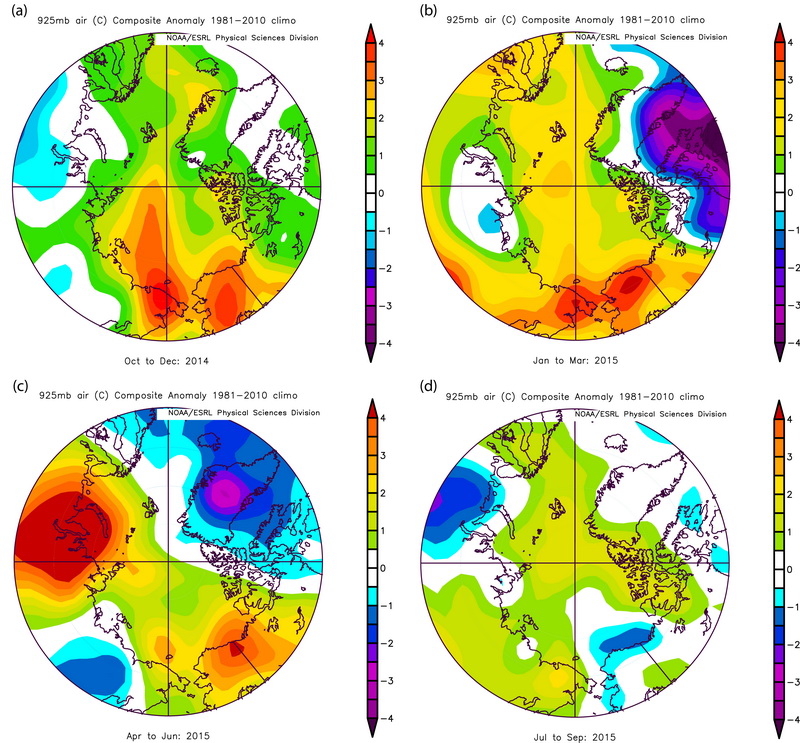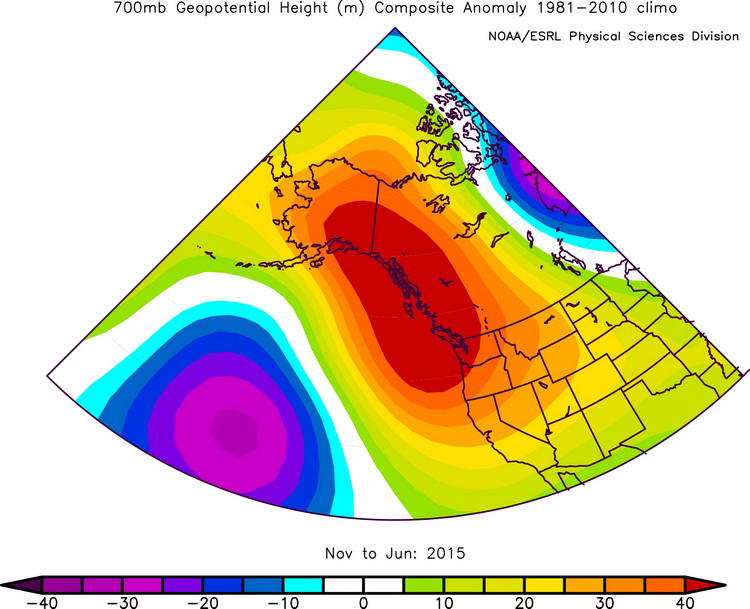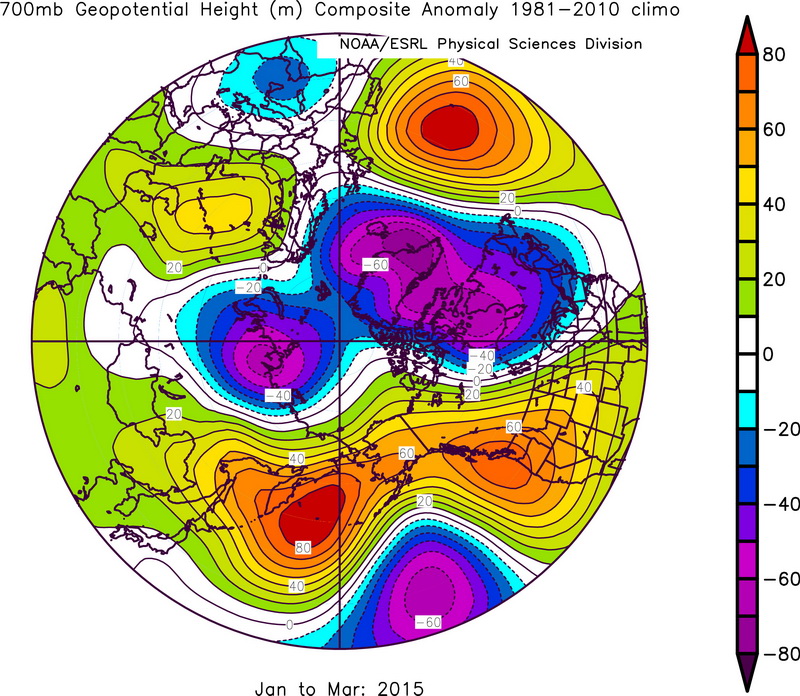J. Overland1, E. Hanna2, I. Hanssen-Bauer3, S. -J. Kim4, J. E. Walsh5, M. Wang6, U. S. Bhatt7, R. L. Thoman8
1NOAA/PMEL, Seattle, WA, USA
2Department of Geography, University of Sheffield, Sheffield, UK
3Norwegian Meteorological Institute, Blindern, 0313 Oslo, Norway
4Korea Polar Research Institute, Incheon, Republic of Korea
5International Arctic Research Center, University of Alaska Fairbanks, Fairbanks, AK, USA
6Joint Institute for the Study of the Atmosphere and Ocean, University of Washington, Seattle, WA, USA
7Geophysical Institute, University of Alaska Fairbanks, Fairbanks, AK, USA
8NOAA, National Weather Service, Fairbanks, AK, USA
Highlights
- Average annual surface air temperature anomaly (+1.3°C) over land north of 60°N for October 2014-September 2015 was the highest in the observational record beginning in 1900; this represents a 2.9°C increase since the beginning of the 20th Century.
- Average air temperature anomalies in all seasons between October 2014 and September 2015 were generally positive throughout the Arctic, with extensive regions exceeding +3°C relative to a 1981-2010 baseline.
- Anomalously warm conditions from November 2014 through June 2015 in Alaska were caused by weather patterns that advected warm mid-latitude air northward from the northeast Pacific Ocean. Anomalously warm Arctic conditions during spring (April, May, June) 2015 across central Eurasia were also due to southerly winds.
- Strong connections between the Arctic and the mid-latitudes were also seen in late winter-early spring (February-April) 2015, when cold air advected south-eastward from the central Arctic resulted in major negative temperature anomalies over eastern North America.
Arctic air temperatures are both an indicator and a driver of regional and global changes. Although there are year-to-year and regional differences in air temperatures due to natural random variability, the magnitude and Arctic-wide character of the long-term temperature increase is a major indicator of global warming (Overland 2009). Here we report on the spatial and temporal variability of Arctic air temperatures during the period October 2014 through September 2015, the 12-month period since the end of the previous reporting period (Overland et al. 2014).
Mean Annual Land Surface Temperature
The mean annual surface air temperature anomaly (+1.3°C relative to the 1981-2010 mean value) for October 2014-September 2015 for land stations north of 60°N is the highest value in the record starting in 1900 (Fig. 1.1). This is an increase of 2.3°C since the 1970s and 2.9°C since the beginning of the 20th century. The global rate of temperature increase has slowed in the last decade (Kosaka and Xie 2013), but Arctic air temperatures have continued to increase. Currently, the Arctic is warming at more than twice the rate of lower latitudes (Fig. 1.1).

The greater rate of Arctic temperature increase than the global increase is referred to as Arctic Amplification. Mechanisms for Arctic Amplification include: reduced summer albedo due to sea ice and snow cover loss; the decrease of total cloudiness in summer and increase in winter; the additional heat generated by newly sea-ice free ocean areas that are maintained later into the autumn; and the lower rate of heat loss to space in the Arctic relative to the sub-tropics due to lowered mean temperatures (Serreze and Barry 2011; Makshtas et al. 2011; Pithan and Mauritsen 2014).
Seasonal Surface Air Temperature Variation
Seasonal air temperature variations are divided into autumn 2014 (October, November, December [OND]), and winter (January, February, March [JFM]), spring (April, May, June [AMJ]) and summer (July, August, September [JAS]) of 2015. All seasons show extensive positive temperature anomalies across the central Arctic with many regional seasonal temperature anomalies greater than +3°C, relative to a 1981-2010 baseline (Fig. 1.2).


Autumn 2014 (OND). A broad swath of warm temperature anomalies stretched across the Arctic, extending from the Pacific to the Atlantic sectors (Fig. 1.2a). The warmest temperature anomalies, centered on Alaska and far eastern Siberia, were due to advection of warm air from the south (for more information, see the section below on Arctic and Mid-latitudes Connections).
Winter 2015 (JFM). As in fall 2014 (Fig. 1.2a), warm temperature anomalies continued to extend across the Arctic, from the Pacific sector to the Atlantic sector. The warmest temperature anomalies, again, were centered on Alaska and far eastern Siberia, including the Chukchi and East Siberian seas (Fig. 1.2b). In Svalbard, in the Atlantic sector northeast of Greenland, winter temperatures were typically 3-4°C above the 1981-2010 average. In contrast, a cold temperature anomaly of minus 2-3°C extended from southwest Greenland to eastern Canada (Fig. 1.2b), and into the eastern United States. Temperature anomalies for coastal Greenland locations are summarized in Table 3.1 in the essay on the Greenland Ice Sheet (Tedesco et al. 2015). The Svalbard and Greenland/eastern Canada warm and cold anomalies, respectively, are described further in the section below on Arctic and Mid-latitudes Connections.
Although there is an Arctic-wide long-term pattern of temperature increases, regional differences can be manifest in any given season based on random variability of the atmospheric circulation. Such a contrast is seen between the high temperature anomalies over the Chukchi and East Siberian seas with the substantial cold anomalies over eastern North America (Overland et al. 2011; Kug et al. 2015).
Spring 2015 (AMJ). A broad swath of warm temperature anomalies continued to stretch across the Arctic, with a continuing warm anomaly over Alaska (Fig. 1c). However, unlike the fall 2014 and winter 2015 patterns (Figs. 1.2a and 1.2b), the spring pattern saw a shift to a very warm anomaly (+4°C) over central Eurasia (Fig. 1.2c), where there were strongly negative snow cover extent anomalies (see the essay on Terrestrial Snow Cover). In contrast, a significant cold anomaly (-3°C) was centered over Greenland (Fig. 1.2c). In contrast to Greenland, spring temperatures in Svalbard were typically 2-2.5°C above the 1981-2010 average, as Svalbard was located on the margin of the broad swath of positive temperature anomalies that extended from Alaska to Eurasia (Fig. 1.2c).
Summer 2015 (JAS). A warm temperature anomaly over much of the Arctic Ocean, with the exception of a moderately cold anomaly over the Beaufort Sea north of Alaska, characterized summer 2015 (Fig. 1.2d). Particularly cold anomalies occurred over western Eurasia. As noted in the essay on the Greenland Ice Sheet, a new record August low temperature of -39.6°C occurred on August 28 at Summit (elevation 3,216 m in the centre of the ice sheet), while summer temperatures at most coastal locations were above average (Tedesco et al. 2015). The role of atmospheric circulation associated with a negative North Atlantic Oscillation on Greenland air temperatures and ice sheet melting is described in the essay on the Greenland Ice Sheet. Similar to coastal Greenland locations, in Svalbard the average summer 2015 temperature was 1-2°C above the 1981-2010 average, and was the highest ever recorded in the composite Longyearbyen-Svalbard Airport record that dates back to 1898 (Nordli et al. 2014).
Arctic and Mid-latitudes Connections
As noted in the previous section, Alaska was anomalously warm in fall 2014, and winter and spring 2015 (Figs. 1.2a, 1.2b and 1.2c). The persistent positive near surface air temperature anomalies in Alaska and extending into the Chukchi and Beaufort seas were associated with warm sea surface temperatures in the Gulf of Alaska and a pattern of geopotential height anomalies characterized by higher values along the Pacific coast of northwestern North America and lower values further offshore (Fig. 1.3). Winds follow the contours of geopotential heights clockwise around high values. Consequently, warm air over the northeast Pacific Ocean was advected into and across Alaska. Associated with the southerly winds, a downslope component of the wind on the north side of the Alaska Range and into Interior Alaska caused dry conditions and reinforced high temperatures. The warm and dry conditions in Interior Alaska during May and June contributed to the second worst fire season on record for those months, eclipsed only by 2004.


In contrast to the warm temperature anomaly in winter in Alaska (Fig. 1.2c) due to warm, southerly air flow (Fig. 1.3), the cold anomaly extending from eastern Canada to southwest Greenland (Fig. 1b) was caused by strong northerly air flow. This cold anomaly extended in to early spring. The cause of these relatively cold temperatures is illustrated by the winter (JFM) geopotential height field anomaly pattern (Fig. 1.4), which shows high values over northwestern North America and low values over eastern North America, Greenland and across the central Arctic Ocean to central Eurasia. As wind flows clockwise and counter-clockwise around high and low height centers, respectively, northerly winds on the west side of the trough between the two centers channeled cold air southward from the source region in the central Arctic into northeastern North America. This geopotential height anomaly pattern also explains the above average winter air temperatures in Svalbard due to warm air advection across western Eurasia and into the central Arctic Ocean (Figs. 1.2b and 1.2c).


References
Kosaka, Y., and S.-P. Xie, 2013: Recent global-warming hiatus tied to equatorial Pacific surface cooling. Nature, 501, 403-407.
Kug, J.-S., J.-H. Jeong, Y.-S. Jang, B.-M. Kim, C. K. Folland, S.-K. Min, and S.-W. Son, 2015: Two distinct influences of Arctic warming on cold winters over North America and East Asia. Nature Geoscience, 8, DOI:10.1038/NGEO2517.
Makshtas A. P., I. I. Bolshakova, R. M. Gun, O. L. Jukova, N. E. Ivanov, and S. V. Shutilin, 2011: Climate of the Hydrometeorological Observatory Tiksi region. In Meteorological and Geophysical Investigations. Paulsen, 2011, 49-74.
Nordli, Ö, R. Przybylak, A. E. J. Ogilvie, and K. Isaksen, 2014: Long-term temperature trends and variability on Spitsbergen: the extended Svalbard Airport temperature series, 1898-2012. Polar Res., 33, 21349.
Overland, J. E., 2009: The case for global warming in the Arctic. In Influence of Climate Change on the Changing Arctic and Sub-Arctic Conditions, J. C. J. Nihoul and A. G. Kostianoy (eds.), Springer, 13-23.
Overland, J. E., K. R. Wood, and M. Wang, 2011: Warm Arctic-cold continents: Impacts of the newly open Arctic Sea. Polar Res., 30, 15787, doi: 10.3402/polar.v30i0.15787.
Overland, J. E., E. Hanna, I. Hanssen-Bauer, B.-M. Kim, S.-J. Kim, J. Walsh, M. Wang, and U. Bhatt, 2014: Air Temperature. In Arctic Report Card: Update for 2014, ftp://ftp.oar.noaa.gov/arctic/documents/ArcticReportCard_full_report2014.pdf.
Pithan, F. and T. Mauritsen, 2014: Arctic amplification dominated by temperature feedbacks in contemporary climate models. Nature Geoscience, doi: 10.1038/ngeo2071.
Serreze, M., and R. Barry, 2011: Processes and impacts of Arctic amplification: A research synthesis. Global and Planetary Change, 77, 85-96.
Tedesco, M., J. E. Box, J. Cappelen, R. S. Fausto, X. Fettweis, T. Mote, C. J. P. P. Smeets, D. van As, R. S. W. van de Wal, and J. Wahr, 2015: Greenland Ice Sheet. In Arctic Report Card: Update for 2015, www.arctic.noaa.gov/Report-Card/Report-Card-2015/ArtMID/5037/ArticleID/219/Greenland-Ice-Sheet.
November 17, 2015